
IC 298, 14m9, 0.7' x 0.5', Ring A&B
Distance: approx. 450 MLy
Cetus
Uranometria: S. 221 (old), S. 118-right (new)
DSS II (5' x 5')
further information:
Messier45.com
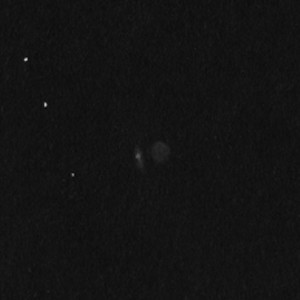
Uwe Glahn, 24", 525x, fst 6m7:
IC 298A ist als leicht N-S elongierte Galaxie mit hellem, stellaren Kernbereich flächig zu sehen; direkt NW sitzt runde, gleichmäßig ausgeleuchtete, flächige IC 298; IC 298 schwächer als IC 298A, jedoch indirekt zu halten; keine Ringstruktur
Uwe Glahn, 16", 360x, fst 6m3:
very difficult pair, under bad conditions (object near the horizon) I could only see a faint glow, elongated to SE, no seperation between the galaxies

Messier 87, 8m6, 8.4' x 6.7', E+0-1 pec
Distance: approx. 60 MLy
Virgo
Uranometria: S. 193 (old), S. 91-left/A 13 (new)
DSS II (5' x 5')
further information:
SDSS Image
Messier45.com

Uwe Glahn, 20x125, fst 6m4:
bright galaxy, nearly circular, barely brighter to the middle
Uwe Glahn, 16", 257x-720x, fst 6m5+:
Very bright, featureless galaxy; concentrated to the center; slightly elongated SE-NW; both companions companion galaxies PGC 139919 (1,9' SW) and PGC 41342 (2,5' SW) are easily seen close to the center; no signs of the jet, even at very high magnifications.
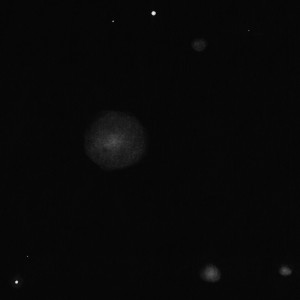
Martin Schoenball, 10",139x, fst 6m3:
Very bright and large galaxy. A typical elliptical, very much brighter middle with a difficult core, featureless
Matthias Juchert, 2,5", fst 6m0:
Large, very bright, situated in a prominent star field, continuous brightening to the center.
Groß, sehr hell, in markantem Sternfeld gelegen, kontinuierliche Helligkeitszunahme zum brillanten Zentrum.
Matthias Juchert, 8", fst 6m4:
Very bright, very large, round-oval, very bright core. The satellite galaxies NGC 4478 and NGC 4476 are visible with averted vision at 98x.

NGC 520, 11m3, 4.5' x 1.8', S pec, Pair
Distance: approx. 100 MLy
Pisces
Uranometria: S. 218 (old), S. 120-left (new)
DSS II (5' x 5')
further information:
Messier45.com
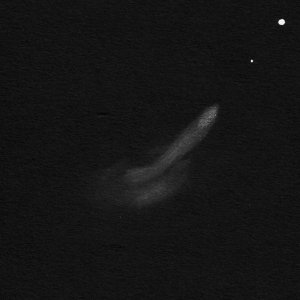
Uwe Glahn, 16", fst 7m1:
first detail is the long, NW-SE elongated
core which breaks at 2/3 to the north, brightest detail lies at the NW-end of the
core, south of the SE-end of the brighter core there is an other bean shape light stream, the dust lane between the two "cores" is hard to detect
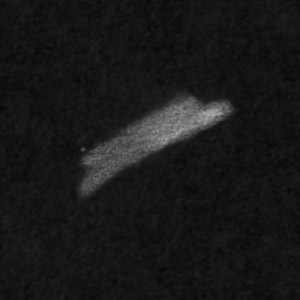
Martin Schoenball, 10", 197x, fst 7m1:
Pretty bright galaxy, highly elongated 5:1. The western part is brighter and brightest at its western tip. The eastern end is splitted. The galaxy gets thinner near the western end. Very interesting but difficult to get the details.
Matthias Juchert, 2,5", fst 6m6:
Faint and extended at 34x, clearly visible with averted vision. Elongated about 3-4:1 PA 135°.

NGC 523, 12m7, 2.5' x 0.7', Pec
Distance: approx. 220 MLy
Andromeda
Uranometria: S. 91 (old), S. 62-left/A 7 (new)
DSS II (5' x 5')
further information:
Messier45.com

Uwe Glahn, 16", fst 7m2:
wow, a secret tip of the Arp-galaxies, 1:4 elongated galaxy with three brighter spots, brightest spot lies on the western end of the galaxy, nearly stellar, second brightest spot lies on the eastern end, diffuse with averted vision, third, much more fainter spot lies in the middle of the galaxy, elongated, very faint glow in the south, a little bit bean shaped with the concave side to the north
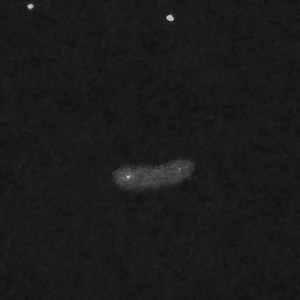
Martin Schoenball, 10", 197x, fst 6m2:
Pretty small galaxy, moderately faint, elongated 4:1 E-W. Two stellar brightenings in east and west. The eastern is a bit brighter and is surrounded by a brighter area. The galaxy is bean shaped with the concave side to north.

NGC 4194, 12m4, 1.8' x 1.1', IBm pec
Distance: approx. 110 MLy
Ursa Major
Uranometria: S. 47 (old), S. 24-left (new)
DSS II (5' x 5')
further information:
SDSS Image
Messier45.com
Uwe Glahn, 16", 225x, fst 6m8:
small, 20"x40" N-S elongated galaxy; consists of two closly fittig parts; brighter part at the N side is 1:2 N-S elongated; smaller part is 1:2 E-W elongated; faint part to the N side is not visible

NGC 4670, 12m2, 1.5' x 1.1', SB(s)0/a pec:
Distance: approx. 50 MLy
Coma Berenices
Uranometria: S. 149 (old), S. 71-left (new)
DSS II (5' x 5')
further information:
Messier45.com
not observed yet

NGC 7236, 13m6, 0.7' x 0.7', SA0-
NGC 7237, 13m9, 0.7' x 0.7', SA0-
Distance: approx. 350 MLy
Pegasus
Uranometria: S. 212 (old), S. 82-right/83-left (new)
DSS II (5' x 5')
further information:
SDSS Image
Messier45.com
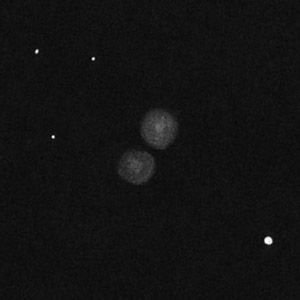
Martin Schoenball, 10", 197x, fst 6m2:
Both galaxies are pretty faint smudges, NGC 7236 (bottom) appearing slightly brighter. Both are round and brighter in the middle and showing a core. The appear separated from each other.

NGC 5613, 14m3, 1.0' x 0.8', (R)SAB(r)0+
NGC 5614, 11m7, 2.5' x 2.0', SA(r)ab pec
NGC 5615, 14m7, 0.2' x 0.2'
Distance: 180 MLy, NGC 5613 approx. 400 MLy
Bootes
Uranometria: S. 111 (old), S. 52-right (new)
DSS II (5' x 5')
further information:
SDSS Image
Messier45.com
not observed yet

UGC 10214, 14m6b, 3.6' x 0.8', SBS5P
Distance: approx. 430 MLy
Draco
Uranometria: S. 51 (old), S. 22-left (new)
DSS II (5' x 5')
further information:
Messier45.com
Martin Schoenball, 10", 197x, fst 6m2:
Tadpole Galaxy, very faint smudge, slightly brighter center, pretty difficult! The tail as far beyond the reach of this telescope!
Uwe Glahn, 16", 180x-257x, fst 6m5+:
Galaxy is
an easy 2:3 E-W elongated smudge; bright central area; no signs of the tail.

NGC 5544, 13m3, 1.0', (R)SB(rs)0/a
NGC 5545, 15m0, 1.3' x 0.4', SA9s)bc:
Distance: approx. 140 MLy
Bootes
Uranometria: S. 110 (old), S. 52-right (new)
DSS II (5' x 5')
further information:
SDSS Image
Messier45.com
Uwe Glahn, 16", 257x, fst 7m0:
beautiful exclamation mark in the sky, round face-on galaxy NGC 5544 lies directly on the edge-on galaxy NGC 5545, both galaxies with same brightness, faint outer range of NGC 5544 too faint to detect visually

NGC 2719, 13m3, 1.4' x 0.3', Im pec?
NGC 2719A, 13m9, 0.9' x 0.6', Im pec:
Distance: approx. 140 MLy
Lynx
Uranometria: S. 102 (old), S. 56-right (new)
DSS II (5' x 5')
further information:
SDSS Image
Messier45.com
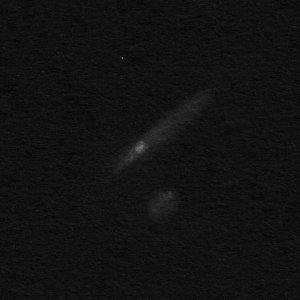
Uwe Glahn, 20", 374x, fst 6m5:
small pair more heavily than expected, both galaxies seperated visually, NGC 2719 1:4 SE-NW elongated, brighter part on its SE end, NGC 2719A south, elongated 1:2 SE-NW, structureless

NGC 1569, 11m2, 3.7' x 1.8', IBm IV-V
Distance: approx. ? MLy
Camelopardalis
Uranometria: S. 19 (old), S. 16-right (new)
DSS II (5' x 5')
further information:
Messier45.com

Uwe Glahn, 16", 488x, fst 6m6:
very interesting galaxy, many knots and visually difficult structure, two very faint stellar SSC's

Martin Schoenball, 10", 274x, fst 6m0:
Very small but pretty bright galaxy. Oval 3:1 E-W, next to a bright star. The galaxy is brighter in its western part, the center lies in the galaxies geometric middle and is very broad. In few moments some fine detail seems to be visible but can't hold them. To review under better conditions!

NGC 3718, 10m6, 8.2' x 4.0', SB(s)a pec
Distance: approx. 45 MLy
Ursa Major
Uranometria: S. 47 (old), S. 24-right (new)
DSS II (10' x 10')
further information:
SDSS Image
Messier45.com
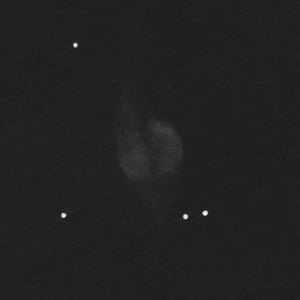
Martin Schoenball, 10", 197x, fst 6m8:
Very bright, large, the galaxy has a round center divided by a dust lane. The western half appears slightly brighter and has a knot to the south. At low magnification faint spiral arms are visible extending straight from the dust lane.

Uwe Glahn, 16", 225x - 320x, fst 6m5:
large 1:2 SE-NW elongated galaxy with moderately surface brightness, brighter central region elongated NE-SW, faint dust lane devides galaxy, only visible at the central region, faint spiral arms N and S

NGC 3310, 10m6, 3.1' x 2.4', SAB(r)bc pec
Distance: approx. 45 MLy
Ursa Major
Uranometria: S. 46 (old), S. 25-left (new)
DSS II (5' x 5')
further information:
SDSS Image
Messier45.com
not observed yet

NGC 3921, 12m2, 2.1' x 1.3', (R' )SA(s)0/a
Distance: approx. 270 MLy
Ursa Major
Uranometria: S. 47 (old), S. 24-right (new)
DSS II (5' x 5')
further information:
SDSS Image
Messier45.com
Matthias Juchert, 8", fst 6m5:
As there are only few stars for orientation it is difficult to observe NGC 3921. At 126x and averted vision one can clearly detect the light of a faint, oval nebula. The pretty bright center is visible with direct vision. A faint star lies in NE. 4,5' further north lies the even fainter NGC 3916.
Uwe Glahn, 20", 293x, fst 6m5+:
The galaxy
appears elongated 3:2 N-S with a bright central area; faint extensions run south
with better defined edges; interesting neigbors around are NGC 3916, PGC 37013
and PGC 2489542.

IC 51, 12m8, 1.4' x 1.2', SO pec?
Distance: approx. 80 MLy
Cetus
Uranometria: S. 261 (old), S. 140-right (new)
DSS II (5' x 5')
further information:
Messier45.com
Uwe Glahn, 16", 257x, fst 7m+:
small galaxy with high surface brightness, 3:2 NE-SW elongated; with higher magnification mottled structure; can not hold small "arms" to the SE and NW, very faint and small

NGC 14, 12m2, 2.8' x 2.1', (R)IB(S)m pec
Distance: approx. 40 MLy
Pegasus
Uranometria: S. 170 (old), S. 81-left (new)
DSS II (5' x 5')
further information:
SDSS Image
Messier45.com
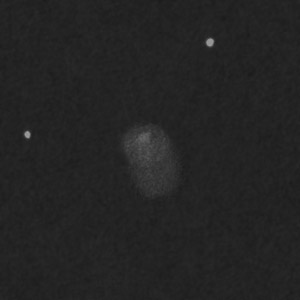
Martin Schoenball, 10", 91x, fst 6m2:
Faint galaxy. Pretty low surface brightness and no brightening to the middle. It is elongated N-S with a brighter northern part. A small condensation lies in the northern part.

NGC 5278, 12m9, 1.4' x 1.0', SA(s)b? pec
NGC 5279, 14m0, 0.6' x 0.4', SB(s)a pec
Distance: approx. 350 MLy
Ursa Major
Uranometria: S. 49 (old), S. 23-right (new)
DSS II (5' x 5')
further information:
SDSS Image
Messier45.com
not observed yet

NGC 5257, 12m1, 1.8' x 0.9', Sb? pec
NGC 5258, 12m1, 1.7' x 1.1', Sb? pec
Distance: approx. 310 MLy
Virgo
Uranometria: S. 241 (old), S. 110-left (new)
DSS II (5' x 5')
further information:
SDSS Image
Messier45.com
not observed yet

NGC 4676A, 13m5, 2.3' x 0.7', S0 pec?
NGC 4676B, 13m8, 2.2' x 0.8', SB(s)0/a pec
Distance: approx. 300 MLy
Coma Berenices
Uranometria: S. 108 (old), S. 53-right (new)
DSS II (5' x 5')
further information:
Messier45.com
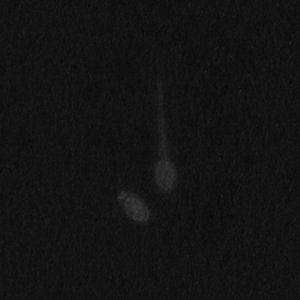
Uwe Glahn, 24", 315x, fst 6m7:
NGC 4676A as a small, 1:2 N-S elongated galaxy; from the northern end a 1,5' long tail started; NGC 4676B somewhat brighter; 1:2 NE-SW elongated with a separated NE-end

NGC 2623, 13m2, 2.4' x 0.7', P: Trip Coll
Distance: approx. 250 MLy
Cancer
Uranometria: S. 141 (old), S. 74-right/75-left (new)
DSS II (5' x 5')
further information:
SDSS Image
Messier45.com
Uwe Glahn, 16", 300x, fst 6m4:
small, nearly circular, extremely faint tail to the NE?

NGC 4038, 10m3, 5.3' x 3.1', SB?(s:)m pec
NGC 4039, 10m4, 3.1' x 1.6', IB:(s)m pec
Distance: approx. 75 MLy
Corvus
Uranometria: S. 328 (old), S. 150-left (new)
DSS II (10' x 10')
further information:
Messier45.com
Martin Schoenball, 10", 100x, fst 6m0:
Low in the sky, NGC 4038 is larger and brighter, NGC 4093 is pretty faint. They appear as two connected oval spots with a dark finge between them.
Matthias Juchert, 8" fst 6m7:
Bright and beautiful interacting pair of galaxies. The galaxies are clearly connected with dark space between them at the west side. The northern NGC 4038 is clearly brighter and round-oval. The ring of HII regions in the western part is not visible with the 8". But there are one or two nearly stellar spots at the western rim which might be bright HII knots or at least one bright star. 126x
Uwe Glahn, 4", 88x, fst 6m5+:
Prominent even at 18x;
at 88x both galaxies are detached; the northern galaxie NGC 4038 is elongated
2:1 E-W; the fainter NGC 4039 is elongated 2:1 NE-SW.
Uwe Glahn, 12,5", 288x, fst 6m5+:
NGC 4038 resolves
in a 2:1 E-W elongated ring with many HII regions, some of them are extended;
NGC 4039 is attached and shows some structure too.
Uwe Glahn, 16", 57x-257x, fst 7m0+:
Even with perfect
transparency under alpine skies, nothing is visible of the tails with all
magnifications; both galaxies are full of details.

UGCA 173, 16m1?, 1.3x0.2, = PGC 27817
UGCA 174, 14m9b, 1.2x0.4, = PGC 27828
Distance: approx. 80 MLy
Sextans
Uranometria: S. 278 (old), S. 113-left/133-left (new)
DSS II (5' x 5')
further information:
Messier45.com
Uwe Glahn, 16", 225x, fst 6m4:
only UGCA 174 visible as a faint, 1:4 E-W elongated galaxy

NGC 3239, 11m1, 5.0' x 3.3', Ib(s)m pec
Distance: approx. 35 MLy
Leo
Uranometria: S. 190 (old), S. 73-right/92-right (new)
DSS II (5' x 5')
further information:
Messier45.com
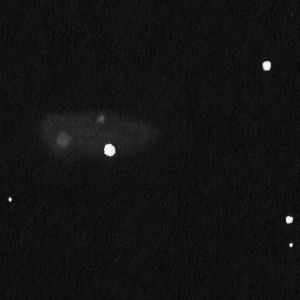
Uwe Glahn, 16", 225x, fst 6m2:
faint, 1:2 E-W elongated galaxy, north of a 10mag star, diffus, brighter knot at the SE end, second smaller and fainter knot N of 10mag star, faint neighbourhood galaxies UGC 5639, PGC 30563, 30564, 30573, 30585 und 30606 15' around

NGC 4861, 13m5, 4.0' x 1.5', SB(s)m:
Distance: approx. 40 MLy
Canes Venatici
Uranometria: S. 108 (old), S. 53-right (new)
DSS II (5' x 5')
further information:
SDSS Image
Messier45.com

Martin Schoenball, 10", 100x, fst 6m7:
I see a pretty bright, stellar object in the center of an equilateral triangle at first. At a closer look it appears diffuse and responds to the UHC filter. This is a huge HII region. North of this object is the main body
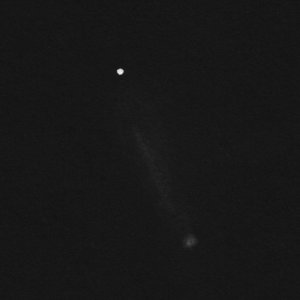
Uwe Glahn, 16", 360x, fst 6m8:
15" small, nonstellar HII region bright; fainter, 3:1 elongated part 2,5' long towards NE; thicker in the middle; brighter part in the middle

Holmberg II, 10m7, 8.0' x 6.3', Im IV-V, = UGC 4305
Distance: approx. ? MLy
Ursa Major
Uranometria: S. 22 (old), S. 14-right/15-left (new)
DSS II (5' x 5')
further information:
Messier45.com

Uwe Glahn, 16", 129x, fst 6m7:
faint glow around a triangle of 13 mag stars, brightest part at the W side of the triangle, 2'x3' elongated, at the E side thin N-S elongated nebula lane, the whole structure ends very dim and diffuse at the N
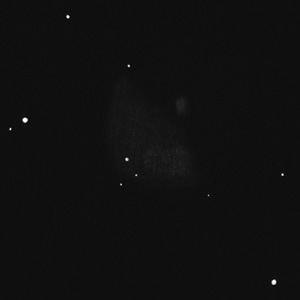
Martin Schoenball, 10", 91x, fst 6m7:
At 39x a bright knot of nebulosity is visible. At 91x some stars are visible surrounded by a very faint haze. Very large and very low surface brightness and irregular shape. A faint, extended knot is visible west of the galaxy body. The galaxy has a relatively sharp eastern edge.